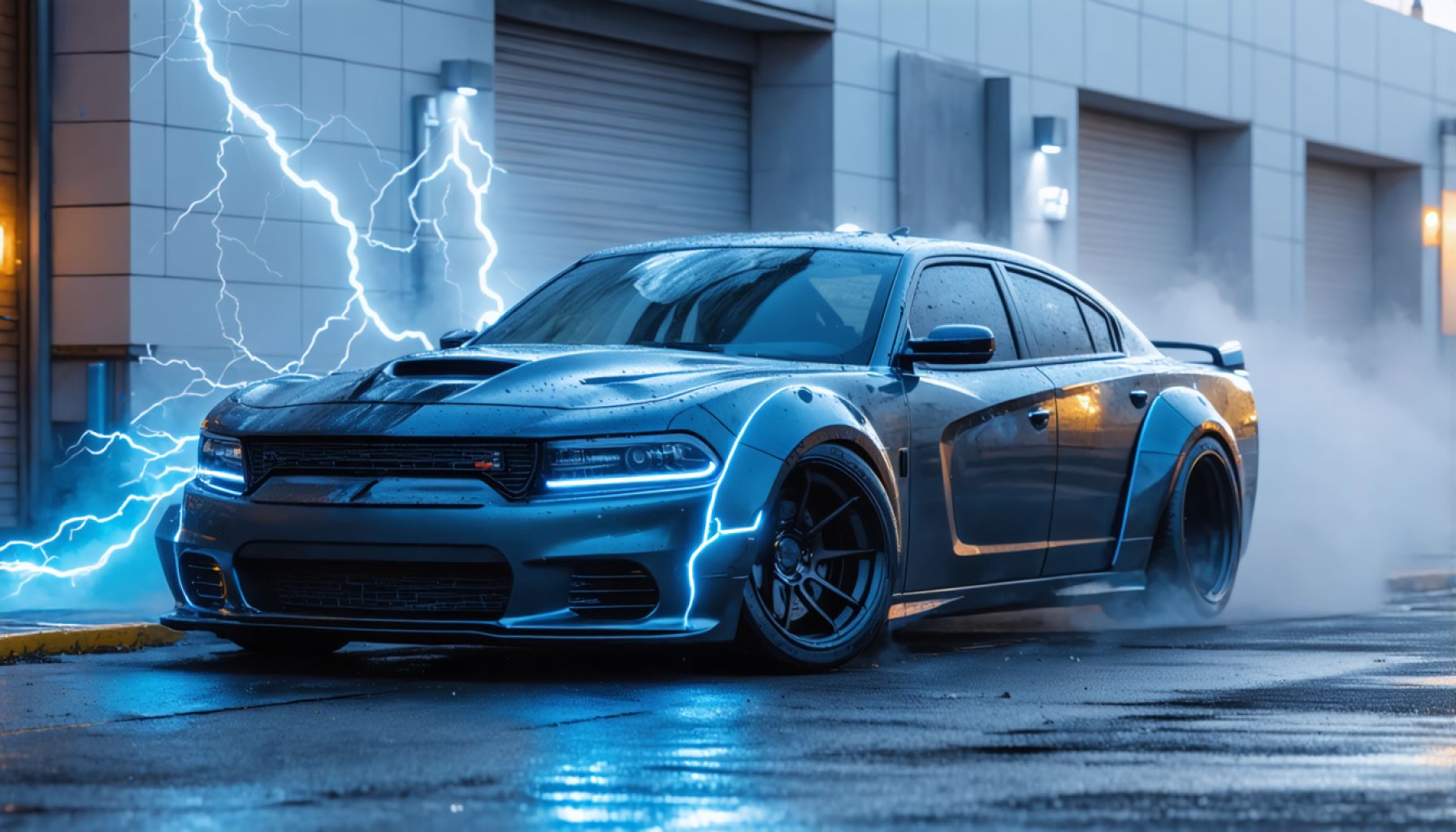- Dark clouds signal an electrifying race between classic and modern automotive power.
- The Dodge Charger represents the golden era of American muscle cars with its roaring V8 engine and 1970s legacy.
- Ford’s electric vehicle showcases future innovation with sleek design and advanced efficiency.
- The race narrative highlights the transition from traditional gasoline engines to electric power.
- The Charger evokes nostalgic emotions with its powerful performance and historical significance.
- Midway, the Ford accelerates smoothly, demonstrating electric vehicles’ technological advancements.
- While the Charger symbolizes timeless muscle, the Ford exemplifies the evolving landscape of modern vehicles.
- This clash underscores the balance between nostalgia and innovation in automotive evolution.
- The rise of electric vehicles promises cleaner energy and a new era of fast, smart, and sophisticated cars.
Dark clouds gathered over the racing strip, setting the stage for an electrifying clash between the past and the future of American muscle. On one side, a classic Dodge Charger, its roaring V8 engine echoing a bygone era of horsepower supremacy. On the other, Ford’s latest electric dynamo, sleek and silent, with power coursing through its wires like a bolt of technological lightning.
This showdown wasn’t just a race; it was a narrative of evolution. The Charger, all muscle and brawn, epitomizes the golden age of American automotive engineering. Its historical significance is undeniable, with its 1970s legacy steeped in speed and style. Yet, even steel lions must face the inevitable march of progress.
Meanwhile, Ford’s electric beast—a far cry from the gas guzzlers of yesteryear—embodies the future. Every inch of its aerodynamic design screams modernity, every software tweak maximizes efficiency and power. As it idles, there’s a hush, an anticipation of the instant torque lying in wait.
The flag drops. They leap forward, the Charger bellowing with robust defiance, tires clawing at the asphalt. For a fleeting moment, nostalgia holds its own, as the sound and fury of internal combustion strike an emotional chord with onlookers. But the electric adversary is biding its time. Like a predator analyzing its prey, the Ford waits for the perfect moment.
Midway through the strip, technology asserts its dominance. The Ford surges ahead, accelerating with a smoothness that belies its ferocity. In mere seconds, it’s clear—cruising effortlessly across the finish line—why electricity might be the lifeblood of tomorrow’s automobiles.
This race, though not exactly close, highlights a pivotal moment in automotive history. The Dodge Charger, with its enduring spirit and timeless charisma, remains a tribute to the muscle car era. But this encounter between the dauntless brawn of the past and the tireless efficiency of the future is a testament to a rapidly evolving landscape.
The key takeaway is clear: while nostalgia will always keep our foot on the past, innovation propels us forward with ever-increasing velocity. As the era of electric performance rises, it brings with it not only cleaner energy but the promise of an exciting new breed of vehicles that are faster, smarter, and more sophisticated than ever before.
The Ultimate Showdown: Classic Muscle vs. Electric Dynamo
Evolution of American Muscle: A Narrative Reimagined
The thrilling race between a classic Dodge Charger and Ford’s latest electric marvel isn’t just a spectacle; it symbolizes the seismic shift in automotive history. This race encapsulates the heart-pounding saga of tradition meeting innovation, providing insights into the future of the automotive industry.
Technical Specs and Performance
1. Dodge Charger V8:
– Engine: V8, a powerhouse known for its raw horsepower.
– Horsepower: A robust 375-485 hp depending on the model year.
– Torque: Approximately 400-490 lb-ft.
– 0-60 mph: Around 4-6 seconds.
2. Ford Electric Dynamo:
– Engine: All-electric powertrain.
– Horsepower: Up to 459 hp in top models.
– Torque: Instant torque delivery, upwards of 600 lb-ft.
– 0-60 mph: As quick as 3-4 seconds.
Real-World Use Cases
– Nostalgia vs. Innovation: Classic muscle cars like the Dodge Charger offer an immersive experience of rumbling engines and a nostalgia-driven connection to the past. Yet, electric vehicles (EVs) like Ford present an eco-friendly, high-tech alternative with fewer maintenance needs, ideal for urban mobility and sustainable commuting.
Industry Trends and Predictions
– Shift Towards Electrification: The automotive industry sees increasing investments in electric vehicle technology, with manufacturers reallocating resources to develop more efficient and affordable EVs. By 2030, electric vehicles could comprise over half of new car sales globally.
– Technological Innovations: Expect advancements in EV battery technology leading to longer ranges and reduced charging times. As infrastructure develops, the charging network will expand, making EV adoption more viable for a larger audience.
Pressing Questions Answered
1. Why Choose Electric Over Gasoline?
– Advantages of Electric Vehicles: Cleaner energy, lower running costs, immediate torque, and high-tech integrations such as AI assistance and autonomous driving capabilities.
– Environmental Impact: Reduction in carbon emissions and reliance on fossil fuels. Initiatives like these align with global sustainability goals.
2. Are Muscle Cars Obsolete?
– Preservation of Heritage: Classic cars continue to hold value as collector’s items and serve as a homage to American automotive ingenuity.
– Hybrid Innovations: Companies are introducing hybrid versions of muscle cars, blending tradition with modern efficiency standards.
Pros & Cons Overview
– Classic Muscle Cars:
– Pros: Rich history, powerful performance, sound that captivates enthusiasts.
– Cons: Less efficient, higher greenhouse emissions, more frequent maintenance.
– Electric Vehicles:
– Pros: Eco-friendly, low operating costs, instant acceleration, reduced maintenance.
– Cons: Limited range depending on battery tech, infrastructure for charging still developing.
Actionable Recommendations
– For Muscle Car Enthusiasts: Consider preserving these classics not just as vehicles but as cultural artifacts. Participate in classic car shows or muscle car clubs to keep the legacy alive.
– For Potential EV Buyers: Assess your daily commute and local EV infrastructure. Research government incentives that could reduce the purchase cost of an EV.
Explore the evolving automotive landscape and stay informed on future trends and technologies Ford and Dodge have to offer.
